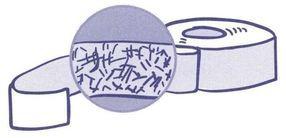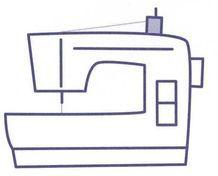Sew Fast Sew Easy: All You Need to Know When You Start to Sew (2 page)
Read Sew Fast Sew Easy: All You Need to Know When You Start to Sew Online
Authors: Elissa K. Meyrich
Tape measure.
This is always a good tool to have. You’ll use it to measure your body, the width of your fabric, the length of your cut …you get the idea. It will also help even your hems. Make sure you buy a good-quality one that will not stretch and has measurements clearly marked on both sides, starting at opposite ends. It could have centimeters if you go shopping in Europe.

Tailor’s chalk, dry kind.
Tailor’s chalk comes in many forms. You want the dry powdery kind; the marks from the greasy type cannot be removed from the fabric.

Dressmaker’s tracing wheel.
Used with dressmaker’s tracing paper, it transfers markings from the pattern to your fabric.
Dressmaker’s tracing paper.
Used with the wheel to transfer markings from the pattern or to draw new lines for alterations.

Magnetic seam guide.
So simple, you’ll wonder why you didn’t invent it. Place this nonslip power-grip magnet on your sewing machine to sew even seams. Definitely a garment industry secret!

Dressmaker’s pins (size 17).
Pins come in all sizes and many varieties. Size 17 will go through most fabrics without leaving large holes.
It is best to get the nickel-plated stainless kind, so they can be picked up by a magnet.

Seam ripper.
Even a good sewer can make a mistake. A seam ripper can be used in two ways: to remove a few stitches or seams, use the point to lift the loops of each stitch and pull out the thread end; to remove larger areas, cut the thread every few stitches (i.e., five), then on the back of the fabric pull the bobbin thread on that side. It should be easy to pull away. If not, cut more threads on the first side.

Hand sewing needles
. Great for hand-sewn hems and small repairs. One package of “household assortment” multisized needles can take care of all your hand repairs.

Tailor’s ham or dressmaker’s ham.
It really does looks like a ham. A hard pillow, the tailor’s ham is an ironing tool, which will help you iron any curved surface, such as darts.

Fuse tape.
Sold under such brand names as Stitch Witchery
®
and Jiffy Fuse
®
, this is a form of glue. You will use it to finish the envelope edges of the pillow and for the slit of the skirt. It’s also useful for quick hem repairs. You iron it on. It is washable and dry cleanable.

Thread to match your fabric
. When selecting thread for garments and crafts, always choose all-purpose thread. There are many different types of threads meant for different purposes. Button and carpet thread is for sewing on buttons or repairing carpets; rayon thread is used for decorative machine stitching,
topstitching,
monogramming, and embroidery. Always be sure to pick a color slightly darker than the predominant color of your garment.

A good sewing machine
. There is nothing more frustrating than a sewing machine that does not work well. Clean your sewing machine with small brushes, cotton swabs, or a can of compressed air. Also, you can call your local sewing machine dealer to schedule a tune-up.
Once you have all of your basic supplies, you’re ready to deal with patterns. There’s no need to buy patterns to make the three projects detailed in this book—they’re conveniently glued to the back cover. But when you’re ready to try something new, keep these things in mind:
1.
In order to purchase the correct pattern (and make clothes that actually fit!), you must know how to correctly take your body measurements. To make skirts and pants, you’ll need waist and hip sizes; for shirts and dresses, don’t forget your bust.
Here’s how to take your measurements:
HOW TO FIND
YOUR ACTUAL
WAISTLINE
